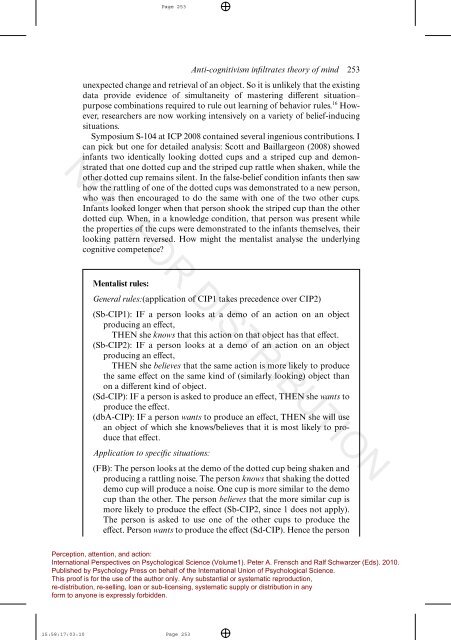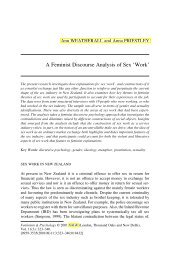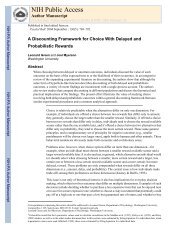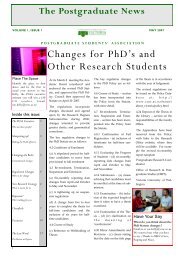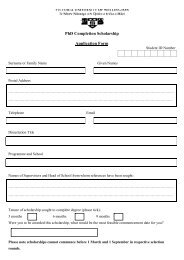Page 252252 <strong>Perner</strong>Do precocious signs of understanding belief meetPovinelli’s Challenge?The meta-analysis by Wellman et al. (2001) showed that despite manyattempts to demonstrate understanding false belief before the age of 4 years,no factor emerged that could reliably achieve this. Single studies reportinglarger proportions of successful younger children appeared to be ephemeralblips. Only the results from using indirect measures of understanding(Clements & <strong>Perner</strong>, 1994) have been replicated on a larger scale after publicationof the meta-analysis. Signs of appreciating false belief appear reliably ina majority of children at or just before the age of 3 years. In the basic set-up,the story protagonist disappears and returns via one of two doors. Thisallows checking on children’s expectations of where the protagonist willreturn by recording their eye gaze. And, indeed, a majority of 3-year-oldslook at the door next to the location where the protagonist thinks his objectis, while almost all of them predict, when asked, that he will reappear at theother door near where the object actually is. This admittedly curious findinghas been securely replicated (e.g., Garnham & <strong>Perner</strong>, 2001; Garnham &Ruffman, 2001; Low, 2007; Ruffman, Garnham, Import, & Connolly, 2001).Moreover, when the object in question disappears from the scene, a similarfinding has been reported in children as young as 2 years (Southgate, Senju, &Csibra, 2007), 13 or even younger (Southgate 2008).Another group of studies claimed even earlier sensitivity to false beliefusing looking time as the dependent measure. The duration of looking at anerroneous action is compared to looking at a successful action. Longer lookingat the successful action than at the erroneous action in cases of false beliefis interpreted as children being surprised about a successful action when theactor has a false belief. These data indicate sensitivity to the protagonist’sbelief as early as 14 or 15 months (Onishi & Baillargeon 2005; Surian, Caldi,& Sperber, 2007). One problem with these data is that the looking-time differencesare multiply interpretable and not a clear indicator of expectation(<strong>Perner</strong> & Ruffman 2005; Sirois & Jackson, 2007). Here I just want to pointout that the looking-time differences 14 and the looking in expectation can beexplained by the use of behavior rules (SA-CIPs).Two features help defend this explanation. (1) The measures employed areall indirect tests 15 as opposed to the direct tests of belief-based behavior in thetraditional false-belief tests. This can explain why 3-year-old children look atthe point of reappearance where the protagonist thinks the object is whereas,when asked, they steadfastly claim that he will reappear from the door nearwhere the object actually is. This is in analogy to implicit memory. Havingseen a word on a list can make it demonstrably more likely to find it as asolution to an anagram (indirect test) even when there is complete failure ofidentifying the word as a member of the list on a (direct) recognition test. (2)These original demonstrations of precocious sensitivity use a quite narrowrange of both belief-inducing situations and response demands – that is,NOT FOR DISTRIBUTIONPerception, attention, and action:International Perspectives on Psychological Science (Volume1). Peter A. Frensch and Ralf Schwarzer (Eds). 2010.Published by Psychology Press on behalf of the International Union of Psychological Science.This proof is for the use of the author only. Any substantial or systematic reproduction,re-distribution, re-selling, loan or sub-licensing, systematic supply or distribution in anyform to anyone is expressly forbidden.15:58:17:03:10Page 252
Page 253Anti-cognitivism infiltrates theory of mind 253unexpected change and retrieval of an object. So it is unlikely that the existingdata provide evidence of simultaneity of mastering different situation–purpose combinations required to rule out learning of behavior rules. 16 However,researchers are now working intensively on a variety of belief-inducingsituations.Symposium S-104 at ICP 2008 contained several ingenious contributions. Ican pick but one for detailed analysis: Scott and Baillargeon (2008) showedinfants two identically looking dotted cups and a striped cup and demonstratedthat one dotted cup and the striped cup rattle when shaken, while theother dotted cup remains silent. In the false-belief condition infants then sawhow the rattling of one of the dotted cups was demonstrated to a new person,who was then encouraged to do the same with one of the two other cups.Infants looked longer when that person shook the striped cup than the otherdotted cup. When, in a knowledge condition, that person was present whilethe properties of the cups were demonstrated to the infants themselves, theirlooking pattern reversed. How might the mentalist analyse the underlyingcognitive competence?NOT FOR DISTRIBUTIONMentalist rules:General rules:(application of CIP1 takes precedence over CIP2)(Sb-CIP1): IF a person looks at a demo of an action on an objectproducing an effect,THEN she knows that this action on that object has that effect.(Sb-CIP2): IF a person looks at a demo of an action on an objectproducing an effect,THEN she believes that the same action is more likely to producethe same effect on the same kind of (similarly looking) object thanon a different kind of object.(Sd-CIP): IF a person is asked to produce an effect, THEN she wants toproduce the effect.(dbA-CIP): IF a person wants to produce an effect, THEN she will usean object of which she knows/believes that it is most likely to producethat effect.Application to specific situations:(FB): The person looks at the demo of the dotted cup being shaken andproducing a rattling noise. The person knows that shaking the dotteddemo cup will produce a noise. One cup is more similar to the democup than the other. The person believes that the more similar cup ismore likely to produce the effect (Sb-CIP2, since 1 does not apply).The person is asked to use one of the other cups to produce theeffect. Person wants to produce the effect (Sd-CIP). Hence the personPerception, attention, and action:International Perspectives on Psychological Science (Volume1). Peter A. Frensch and Ralf Schwarzer (Eds). 2010.Published by Psychology Press on behalf of the International Union of Psychological Science.This proof is for the use of the author only. Any substantial or systematic reproduction,re-distribution, re-selling, loan or sub-licensing, systematic supply or distribution in anyform to anyone is expressly forbidden.15:58:17:03:10Page 253


